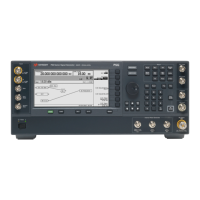Keysight Signal Generators Programming Guide 271
Creating and Downloading Waveform Files
Programming Examples
{
fprintf(stderr, “iopen failed (%s)\n”, instOpenString);
return -1;
}
// Declare variables to hold portions of the SCPI command
int bytesToSend;
char s[20];
char cmd[200];
bytesToSend = numsamples*4; // calculate the number of bytes
sprintf(s, “%d”, bytesToSend); // create a string s with that number of bytes
// The SCPI command has four parts.
// Part 1 = :MEM:DATA “filename”,#
// Part 2 = length of Part 3 when written to a string
// Part 3 = length of the data in bytes. This is in s from above.
// Part 4 = the buffer of data
// Build parts 1, 2, and 3 for the I and Q data.
sprintf(cmd, “:MEM:DATA \”WFM1:FILE1\”, #%d%d”, strlen(s), bytesToSend);
// Send parts 1, 2, and 3
iwrite(id, cmd, strlen(cmd), 0, 0);
// Send part 4. Be careful to use the correct command here. In many
// programming languages, there are two methods to send SCPI commands:
// Method 1 = stop at the first ‘0’ in the data
// Method 2 = send a fixed number of bytes, ignoring ‘0’ in the data.
// You must find and use the correct command for Method 2.
iwrite(id, iqbuffer, bytesToSend, 0, 0);
// Send a terminating carriage return
iwrite(id, “\n”, 1, 1, 0);
printf(“Loaded file using the E4438C, E8267C and E8267D format\n”);
return 0;
}

